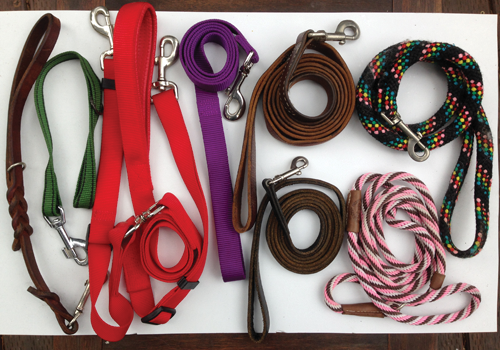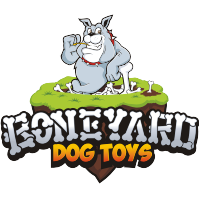Leashes are an extension of our hand and are meant to provide control
The leash is an essential piece of equipment for any dog owner for many types of obedience training.
Selecting a leash that is appropriate for the dog's size and weight are the first steps. If your puppy is old enough to walk in public spaces (i.e. vaccinated), then your first leash may be a smaller version than your final leash.

A typical selection of leashes
Leashes come in a variety of materials including leather, braided cotton, braided polypropylene and nylon web. No doubt there are more to add to the list, but those are the most popular types you're likely to encounter in the pet store.
What about retractable or flexi leashes you ask?
In the dog world, whether or not a retractable leash is safe, ranks near the top of the list of controversal topics. Putting aside for a moment whether retractable leashes accomplish the primary objective of a leash, control, anyone choosing to use one should become familar with public sentiment surrounding their use.
Selecting the right leash is not rocket science but there are a few guidelines to consider.
A leash should feel comfortable in your hand as well as fit the size of your dog.
The size or diameter of the leash should match the weight and strength of your dog. Remember, the strength of the leash depends on the sum of all its parts; clasp, stitching and leash. Just because the nylon web is rated for 1000 lbs doesn't mean the stitching will also hold out.
Inspect the quality of the clasp. Is it easy to open and close? Will it hold up to moisture over time?
Inspect the stitching, particularly where it secures the clasp. Will it hold up over time?
There are a variety of lengths and each has its use. For most purposes, the 48 or 60
inch length is ideal because your goal is to keep your dog at your side. For certain behavior training exercises like "stay in place" some will opt for the 72
inch length.
There is a short lead that is usually 18 inches long. This length is ideal for a large dog that already walks well on a leash. The extra length is just extra baggage.
There are also long leads that come in 20 - 30 foot lengths and are intended for "off leash" field training. In these types of exercizes, like stay/recall, the dog is given a lot of latitude but with a long lead can still be corrected. To safely shed the leash, see the discussion on off-leash training.
How does the handle and the leash feel in your hand? If your dog is new to a leash, training them not to pull will take a toll on your hands if the edges of the leash feel sharp or rough. This is usually the case with flat nylon web style leashes. To avoid this, try the 6 foot leash by Paw Lifestyles that has a padded handle. The webbing is also much thicker for a more durable leash. Another option are the rope leads
. These are usually made of a braided nylon rope for strength and the handle is much softer in the hand. The MW Dog Leash
is yet another approach that braids together nylon web for a very comfortable lead.
Another style of leash are the slip leads. There are the dime a dozen variety that are made of polypropylene rope and are useful for temporary restraint such as bathing or transport. There are also higher quality leads, like the thicker Remington Rope Slip leads that are made of soft braided nylon rope. They will have a leather slide near the noose end that adjusts to the dog's neck size and limits the noose from sliding open more than needed.
For a different type of leash, check out the WACKYwalk'r Urban Leash. The leash is elastic. The idea is that as your dog begins to pull he meets increasing resistance. This type of leash is probably best suited to a dog that has some leash experience and now just needs minor corrections for a soft walk.
Walk more than one dog at a time? There are leashes that split at the end and provide for attachment to two dogs. The Sofi's Leash Coupler is nice because the length of each lead of the splitter is adjustable making it possible to walk dogs of different sizes. Keep in mind these systems are best when used with dogs that already walk well on a leash. Because you're now attached to multiple dogs, if one dog needs correcting, you won't be able to give individual directions using the leash.
If you frequently jog with your dog on a leash you may want to consider the Beyond Control leash by Canine Equipment. This is a multi-purpose leash and features the ability to clip it around your waist leaving your hands free.
There are a few leash accessories worth mentioning. Every responsible dog owner knows they must carry with them poop bags to clean up afterwards. A convenient way to ensure you always have one ready is to attach a bag caddie to your leash. The caddie holds a roll of disposable bags. The Earth Rated dispenser is nice because the bags come in scented or unscented versions and the caddie attaches to your leash and easily dispenses the bags which can then be clipped to the caddie when full. Reasonable refill rolls
are also available.
If you find you're walking your dog in the dark a lot there are solutions that will make your walk safer. There are reflective leashes like the Nite Brite leash by Four Paws as well as leashes that either incorporate LED lights in their construction or that can be attached to your leash. These solutions make you visable to others.
Walking on a leash is a learned behavior
In most cases, dogs must be taught not to pull against the leash and remain walking on one side next to you.
Whether you're using a pressure/release technique, a reward system or a redirection technique, your goal is to have your dog walking beside you with the leash slack. The training technique you use will determine the second essential piece of equipment necessary; the collar or harness. For a complete discussion on choosing the right collar or harness, see our page on collars and harnesses.
Sign up for our FREE report.
"What Trainers Say About Using Toys During Training"
To receive a digital copy of our 15-page report, click on the eReport image above. The book covers some interesting applications of toys used by dog trainers to reinforce behaviors.
Your email address is totally secure and will only be used to send you the report.


